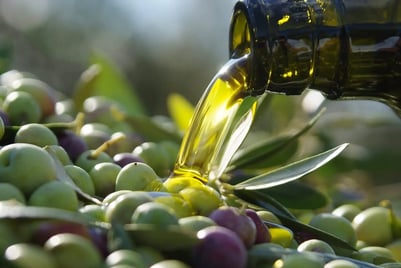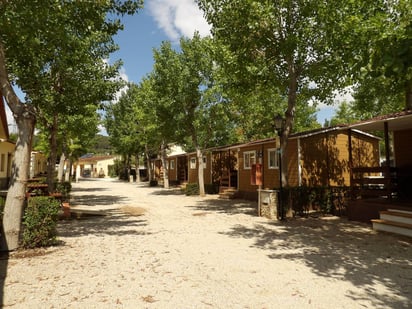If you live on the northern Costa Blanca or are on holiday there, you can't miss them: olive trees. They are everywhere – from the valleys around Jalón and Llíber to the hills near Altea and Dénia. And all these trees together produce one of the region's most typical products: extra virgin olive oil, with its many health benefits. The oil is rich in antioxidants and vitamin E, contains monounsaturated fats and is good for the heart and blood vessels. This makes it part of the Mediterranean diet, which is known worldwide for its health benefits. And then there's the taste. Fruity, spicy or mild and smooth – olive oil from this region surprises with its versatility and character.
When is harvest time?
The harvest period usually runs from October to December, depending on the weather and the type of olive.
-
- Early harvest (October/November): produces an oil with a fresher, grassy taste and a beautiful green colour.
- Late harvest (December): the olives are riper and the oil tastes softer and milder.
How are the olives harvested?
Olive harvesting is still a special sight in the northern Costa Blanca. Traditionally, this is done by hand: families lay large nets under the trees and beat the branches with sticks so that the olives fall to the ground. The fruits are then carefully gathered and collected in crates.
Increasingly, light mechanical aids are also being used, such as compact shaking machines that vibrate the branches. This speeds up the work and prevents the olives from remaining on the tree for too long. In large commercial orchards, you sometimes even see machines that can harvest entire trees in a short time, but in the mountainous areas around Jalón, Benissa and Guadalest, manual harvesting remains the norm.
This harvest time transforms the landscape into a lively scene: everywhere you hear the rustling of the nets, the hum of the shaking machines and the smell of freshly harvested olives. It's hard work, but you do it for the weather.
How are the olives processed?
After harvesting, the olives are often spread out in the sun for a few days in traditional villages to dry slightly. This is an ancient method which, according to local producers, ensures a softer, fuller flavour. More modern producers, on the other hand, press the olives immediately to preserve maximum freshness.
The olives are then taken to an “almazara” (olive mill), where the following happens:
-
- Cleaning and washing – twigs and leaves are removed and the olives are rinsed.
- Grinding – the whole olive (including the stone) is ground into a paste.
- Cold pressing/centrifuging – the oil is separated from the water and pulp without heating.
- Filtering – for a clear oil (some producers bottle unfiltered oil, which is cloudy but full of flavour).
This process is carried out as quickly as possible to prevent oxidation, which means that the best olive oil is in tanks just a few hours after harvesting.
The flavours of olive oil – varieties and uses
Each type of olive has its own character, which you can taste in the oil. In Spain, you will find a whole range of varieties.
The soft, fruity Arbequina, for example, with a hint of almond, is ideal for use raw: on a salad, with a piece of bread or even in sweet dishes.
The Blanqueta, a variety that grows mainly around Alicante, has a little more spice and gives stews and traditional tapas extra depth. Manzanilla produces a mild, round oil with light fruity notes; these olives are also often eaten as table olives.
For those looking for a stronger flavour, there is Picual – intensely green, with a hint of tomato – which also remains very stable when heated and is therefore excellent for frying or cooking. Hojiblanca, on the other hand, is somewhat milder and slightly sweet, making it ideal for sauces, mayonnaise or a light vinaigrette. Cornicabra is a robust oil, full of green leaf aromas, while a Coupage, a blend of different varieties, provides a beautifully balanced, rounded flavour.
In the northern Costa Blanca, Arbequina, Blanqueta and Manzanilla are mainly used, either pure or blended. We recommend tasting three different oils side by side during a tasting session. This will allow you to discover how different they taste, depending on the orchard they come from.
In short, which oil should you use for what?
-
- For cold dishes (salads, bread, alioli): mild Arbequina or a fresh Coupage
- For sauces or other dishes that are not heated: slightly sweet Hojiblanca or mild Arbequina
- For frying and cooking: Picual or Cornicabra (but do not heat too much, so that the flavour and healthy substances are preserved)
Oleoturismo – on the road for an olive experience
In Spain, it is called oleoturismo: tourism centred around olives and olive oil. More and more producers on the northern Costa Blanca are offering tours, tastings and workshops where you can learn everything about olives, from tree to bottle. Here is an overview of five olive oil tastings on the northern Costa Blanca:
-
- Relleu (Señoríos de Relleu) – Modern olive oil mill with interactive tour, tasting and walking routes through the orchards.
- Cooperativa Virgen Pobre (Benissa) – Authentic cooperative where you can see how local families have been making oil for generations.
- Cooperativa San Vicente Ferrer (Teulada) – Guided tours during the harvest, followed by tastings.
- Castell de Castells – Small-scale and authentic, combine a visit with a walk to the rock paintings of Pla de Petracos.
- Oli El Comtat (Cocentaina, slightly inland) – Known for its top-quality extra virgin oil, with a shop and tastings.
Tip: Plan your visit between late October and December, when the olives are harvested and pressed on site.
What makes the oil HERE so special?
What makes olive oil from the Costa Blanca North so unique starts with the environment itself. The trees grow here on calcareous soil, bathed in sunshine and with little rain. This gives the oil a powerful, full flavour that you recognise immediately. Many of these olive trees have been standing for decades, sometimes even centuries, and are still harvested in almost the same way as in the past: by hand, with nets under the trees and often by families who have passed on this craft from generation to generation.
Freshness also plays an important role. If you buy a bottle from a cooperative or mill in the region, you will often taste oil that was pressed that same winter. You can take a bottle home not only as a condiment, but also as a reminder of the beautiful orchards and the Spanish light.
How should you store olive oil?
Olive oil is pure nature and needs a little care to preserve its flavour for as long as possible. It is best to store your bottle in a cool, dark cupboard, away from the cooker, where the temperature remains around 14 to 18 degrees. There is no need to keep it in the fridge: this makes the oil cloudy and repeated heating and cooling is not good for the quality.
The packaging also makes a difference. Dark glass bottles, stainless steel cans or ceramic jugs keep out light and air. It is better to buy smaller quantities, close the cap tightly after use and, if necessary, use a small pourer for everyday cooking, while keeping the rest sealed.
And trust your senses: good olive oil smells fresh and fruity and gives that slight tingle at the back of your throat. If the smell becomes stale and the taste flat, the oil has lost its strength. With a little care, your liquid gold will stay at its best for a long time.
IN SHORT
On the northern Costa Blanca, olive oil is not just about the product, but about the whole experience from orchard to bottle. Taking a bottle (or more) home with you? It's a tasty reminder of your time in Spain.








